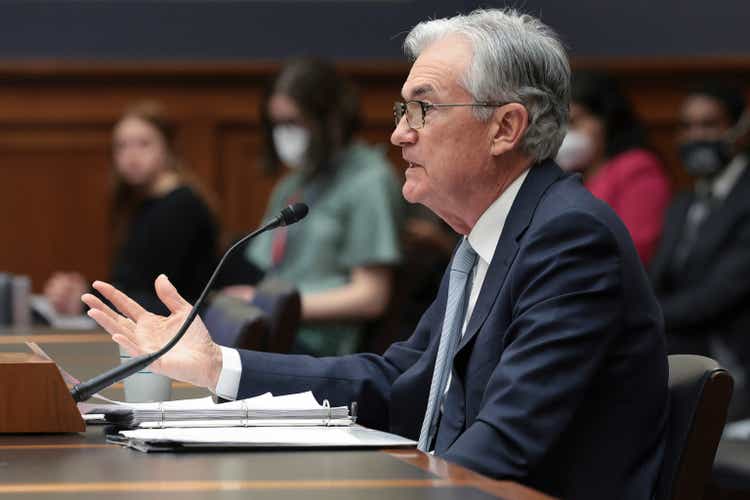Win McNamee/Getty Images News
The Federal Reserve’s plan for interest rates would miss its target of two percent inflation, not even with some good luck. It won’t take too much more than the Fed is currently planning if they change plans soon, as seems likely. Look for short-term interest rates of at least 5 ½% in 2023.
The Fed’s first big policy mistake of the pandemic era was having “the courage to act.” That was the title of Ben Bernanke’s memoir about running the Fed during the 2008-09 financial crisis. But feeling that one must “do something, anything” in a crisis does not take courage. What takes courage is patience. The Fed, without that courage, provided funds for the huge fiscal stimulus programs of both the Trump and Biden administrations.
Their second mistake was mischaracterizing demand-driven inflation as transitory. There certainly were some transitory elements. The best example is the rise in oil prices after the Russian invasion of Ukraine. But the earlier rise in oil prices was not a supply shock like in 1973 and 1979. The 2021 runup of oil prices was triggered by stimulus inducing more driving and more factory use of oil. Similarly, the huge increase in the prices of used cars was not caused by a sudden collapse of supply; it was simply a lot of people with stimulus checks trying to upgrade their rides. Delving into the details of the inflation report is actually deceiving. Every little item has a story behind it, often hiding the truth that excessive demand—caused by excessive stimulus—was the root cause of the inflation.
Although Federal Reserve officials now seem to acknowledge their first mistake, they still have not fully accepted their second.
To estimate how high interest rates must rise to bring inflation down, I first pulled out some likely transitory factors. That brings inflation down but not nearly to the Fed’s target of two percent. Next I ran the Fed’s recent interest rate increases plus their anticipated rate increases through the historical average response of inflation. That helped but did not hit the Fed’s target. This simplistic model indicated that two increases of 50 basis points each early in 2023 would do the trick. The Fed Funds rate would peak at 5.38% and then could be cut a little in 2024.
But that simplistic approach misses some critical factors. No model can account for everything going on in the economy, so the forecaster must consider whether the response of inflation to monetary policy will be weaker and slower this time around or stronger and faster. These factors were described in my recent article on the timing of the next recession. Two issues stood out: the high recent savings of consumers will slow the impact of higher interest rates on the overall economy, and many companies will eliminate unfilled positions before laying off current employees.
Arguing for a faster response of inflation to monetary policy is the Fed’s balance sheet changes. In the pandemic, they not only cut interest rates but they also bought billions of dollars of long-term bonds and mortgage-backed securities. The Fed is now unwinding that ballooning of their balance sheet, which is additional tightening beyond the change in the Fed Funds rate. However, the pace of this change has been pretty small so far.
With these two factors slowing the economy’s response to high interest rates, the Fed will face a difficult choice in 2023: get rates high enough and then wait patiently, or keep raising interest rates until the target is achieved. The few dovish voices within the Fed will argue for the first point, and the Fed’s econometric models will support that approach. Panic and concern about political fallout from excessive, ongoing inflation will lead the hawks to support continued rate increases. What is clear, however, is that the Fed’s September 2022 projections will not be enough.
Fed chair Jerome Powell said that explicitly after the November FOMC meeting, “… incoming data since our last meeting suggest that the ultimate level of interest rates will be higher than previously expected.”
The Fed will have to push the Federal Funds rate up at least to five percent. They could succeed with either a long period at five or a shorter period moving up to six percent. Right now they seem poised to keep pushing rates up, but eventually their models will tell them to just pause and wait for the time lags to work through.
Some monetary policy experts will scoff at this approach, favoring examination of money supply aggregates. The criticism of focusing on interest rates is often valid, especially as changes in inflation swing real interest rates around. Unfortunately, the monetary aggregates do not tell a clear enough story to reach an idea of how high interest rates will go. For consumers and businesses making financial decisions today, that’s a very important question.
In short, expect short-term interest rates to rise above five percent next year, with long-term rates, such as mortgages, even higher.
Editor’s Note: The summary bullets for this article were chosen by Seeking Alpha editors.


Be the first to comment